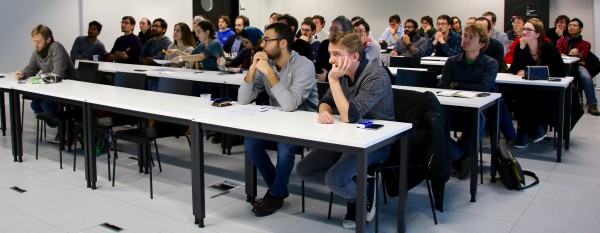MARVEL Junior Seminar — August 2020
Zoom meeting link:
https://epfl.zoom.us/j/93881551248
Password: 3417
The MARVEL Junior Seminars aim to intensify interactions between the MARVEL Junior scientists belonging to different research groups.
Each seminar consists of two presentations of 25 minutes each, allowing to present on a scientific question in depth, followed by time for discussion. The discussion is facilitated and timed by the chair.

MARVEL Junior Seminar Organizing Committee — Giuliana Materzanini, Stefano Falletta, Markus Stricker, Kristians Cernevics, Max Veit and Patrick Mayor
Talk 1 — On-surface synthesis of non-benzenoid nanographenes by oxidative ring-closure and ring-rearrangement reactions
Kristjan Eimre,1 Thorsten G. Lohr,2 José I. Urgel,1,3 Junzhi Liu,4 Marco Di Giovannantonio,1 Shantanu Mishra,1 Reinhard Berger,2 Pascal Ruffieux,1 Carlo A. Pignedoli,1 Roman Fasel,1,5 and Xinliang Feng2
1nanotech@surfaces, Empa
2Center for Advancing Electronics and Faculty of Chemistry and Food Chemistry, TU Dresden
3IMDEA Nanoscience, Madrid
4Dept. of Chemistry and State Key Laboratory of Synthetic Chemistry, University of Hong Kong
5Dept. of Chemistry and Biochemistry, University of Bern
Nanographenes (NGs) have gained increasing attention due to their immense potential as tailor-made organic materials for nanoelectronics and spintronics. They exhibit a rich spectrum of physicochemical properties that can be tuned by controlling the size or the edge structure or by introducing structural defects in the honeycomb lattice. Here, we report the design and on-surface synthesis of NGs containing several odd-membered polycycles induced by a thermal procedure on Au(111). Our scanning tunneling microscopy, noncontact atomic force microscopy, and scanning tunneling spectroscopy measurements, complemented by computational investigations, describe the formation of two nonbenzenoid NGs (2A,B) containing four embedded azulene units in the polycyclic framework, via on-surface oxidative ring-closure reactions. Interestingly, we observe surface-catalyzed skeletal ring rearrangement reactions in the NGs, which lead to the formation of additional heptagonal rings as well as pentalene and as-indacene units in 2A,B, respectively. 2A,B on Au(111) both exhibit narrow experimental frontier electronic gaps of 0.96 and 0.85 eV, respectively, and Fermi level pinning of their HOMOs together with considerable electron transfer to the substrate. Ab initio calculations estimate moderate open-shell biradical characters for the NGs in the gas phase.
Talk 2 — Operators in quantum machine learning: Response properties in chemical space
Anders Steen Christensen, Anatole von Lilienfeld
chemspacelab, Dept. of Chemistry, Uni Basel
The role of response operators is well established in quantum mechanics. We investigate their use for universal quantum machine learning models of response properties in chemical compounds. After introducing a theoretical basis, we present and discuss numerical evidence based on measuring the potential energy’s response with respect to atomic displacement and electric fields. Prediction errors for corresponding properties, atomic forces, and dipole moments improve in a systematic fashion with training set size and reach high accuracy for small training sets. Prediction of normal modes and infrared-spectra of small molecules demonstrates the usefulness of this approach for chemistry.
Check the list of the next MARVEL Junior Seminars here.
Low-volume newsletters, targeted to the scientific and industrial communities.
Subscribe to our newsletter